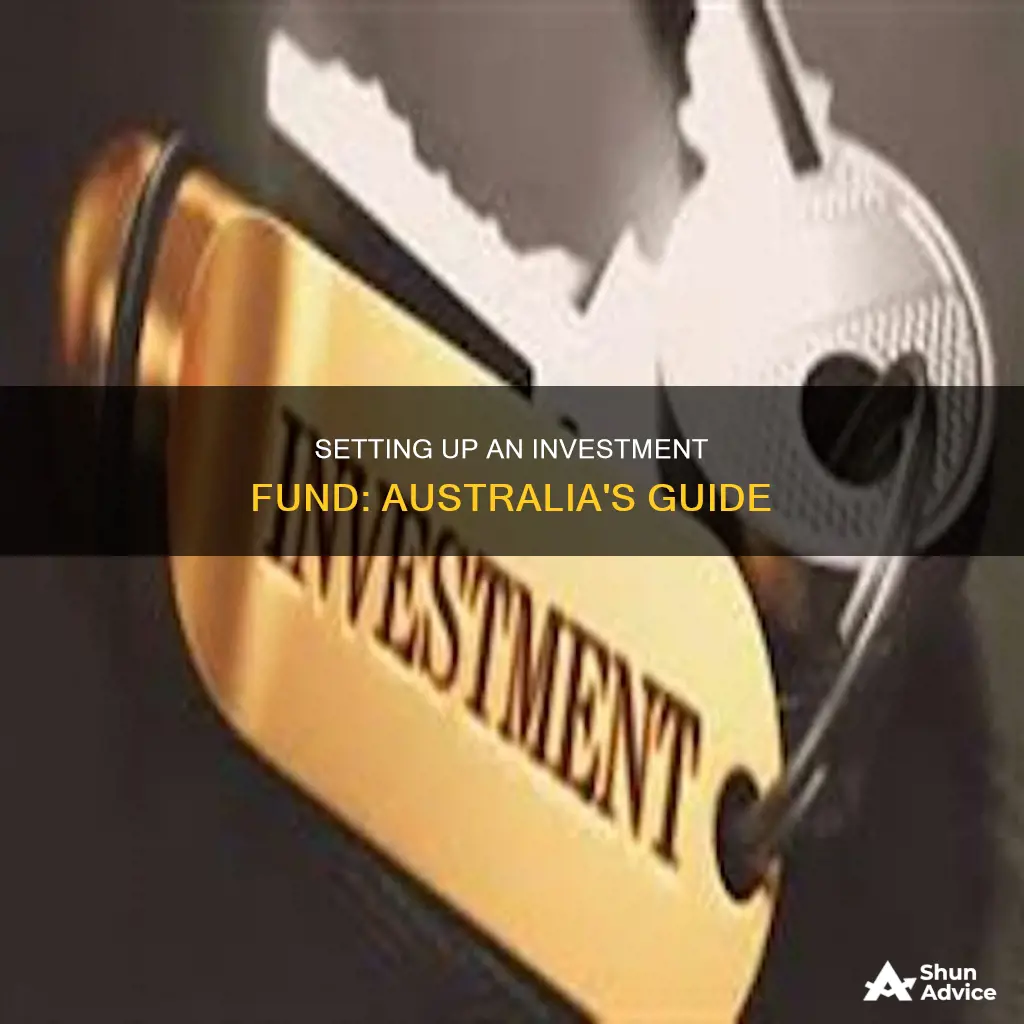
Australia is an attractive destination for investors due to its sophisticated securities market, favourable tax regime, and stable economy and politics. To set up an investment fund in Australia, you must first develop a business plan and register your business with the Australian Securities and Investments Commission (ASIC). Next, you will need to obtain an Australian Financial Services (AFS) licence, which requires relevant qualifications, such as a bachelor's degree, passing an exam, and having professional experience. You will also need to open a bank account, apply for an Australian Business Number (ABN), and register for Goods and Services Tax (GST). Additionally, it is important to market your investment firm to potential clients through various channels.
What You'll Learn

Understanding the regulatory environment
The regulatory environment in Australia is well-developed and provides significant protections for investors. The country has a comprehensive system of licensing, disclosure, and continuous disclosure requirements for companies listed on the Australian Securities Exchange (ASX).
To set up an investment fund in Australia, you will need to be familiar with the following laws and regulations:
- Corporations Act 2001: This legislation governs the establishment and operation of companies in Australia, including the requirements for registering a managed investment scheme.
- Australian Securities and Investments Commission Act 2001: This Act establishes the Australian Securities and Investments Commission (ASIC), which is responsible for regulating the securities and investments industry.
- Financial Services Reform Act 2001: This Act sets out the regulatory framework for the financial services industry, including the licensing and disclosure requirements for financial products.
- National Consumer Credit Protection Act 2009: This legislation protects consumers in the credit and financial industry, ensuring fair practices and responsible lending.
Additionally, the ASIC has specific requirements for registering a managed investment scheme, which is often how investment funds are structured. A managed investment scheme is when a group of investors pool their money together, and a "responsible entity" manages, oversees, and operates the scheme.
To register a managed investment scheme, the proposed responsible entity must:
- Be a registered Australian public company.
- Hold an Australian Financial Services (AFS) license, which allows the entity to provide financial advice and services. The AFS license requires relevant qualifications, such as a bachelor's degree, passing an exam, and having professional experience.
Furthermore, when registering a managed investment scheme, you will need to submit an application (Form 5100) and include the following:
- The kind of scheme being registered, such as financial asset schemes, direct real property schemes, stable property trusts, or service strata schemes.
- A copy of the scheme's constitution.
- A copy of the scheme's compliance plan.
- Form 5103: A statement signed by the directors of the proposed responsible entity, confirming that the scheme's constitution and compliance plan meet the required standards.
It is important to note that unregistered managed investment schemes, or "unregistered schemes," may exist if they have fewer than 20 members. Operators of these schemes must generally hold an AFS license to issue, vary, and dispose of interests in the scheme.
In addition to the above, investment funds in Australia may also take the form of trust funds. There are several types of trust funds recognised in Australia, each with its own specific requirements:
- Discretionary trusts: These are the most common type of trust funds in Australia, allowing flexible distribution of assets.
- Fixed trusts/unit trusts: In this type of trust, assets are split into units, and unit holders receive their distribution at the end of each year.
- Testamentary trusts: These trusts are set up after the death of an individual, following the terms of their will, and are often used when children are too young to manage finances.
- Special disability trusts (SDT): SDTs are used to cover the costs of care for individuals with severe disabilities and must be verified by Services Australia.
- Charitable trusts: These trusts distribute assets to elected charities annually until depletion.
Mutual Funds: Beat Inflation with Smart Investing
You may want to see also

Choosing a business structure
When setting up an investment fund in Australia, there are several business structures to choose from, each with its own advantages and disadvantages. Here are some options to consider:
Sole Proprietorship
A sole proprietorship is a business structure where a single individual owns and operates the investment firm. This structure is relatively simple to set up and provides the owner with complete control over decision-making and business operations. However, it's important to note that the owner is also personally liable for any debts or liabilities incurred by the business.
Partnership
A partnership involves two or more individuals who agree to run the investment firm together. Partnerships can benefit from the combined skills, resources, and capital of the partners. Additionally, the shared responsibilities and decision-making can reduce the burden on any single individual. However, it is crucial to establish a clear partnership agreement outlining the roles, responsibilities, and ownership percentages of each partner.
Company
Incorporating a company as a business structure means the investment firm becomes a separate legal entity from its owners. This structure offers limited liability protection, as the company's debts are separate from the owners' personal assets. There are different types of companies to consider, such as a proprietary limited company (Pty Ltd) or a public company. Each type has its own requirements and is suited to different needs in terms of ownership, control, and fundraising capabilities.
Trust
A trust is a unique business structure where assets are held and managed by a trustee for the benefit of beneficiaries. Trusts can be useful for tax planning and asset protection. There are various types of trusts recognised in Australia, including discretionary trusts, fixed trusts, testamentary trusts, and charitable trusts. Each type has specific characteristics and is suitable for different situations, such as family wealth distribution, estate planning, or charitable giving.
When choosing a business structure, it is essential to consider factors such as liability protection, tax implications, ownership, control, and the level of complexity involved in setting up and managing the structure. It is always recommended to seek professional advice from legal and financial experts to ensure you select the most appropriate structure for your investment fund in Australia.
Liquid Fund Investment: Axis Liquid Fund Guide
You may want to see also

Raising capital and hiring staff
Raising capital is a critical step in growing your business, and there are several ways to raise capital in Australia. This can be done through peer-to-peer lending, initial coin offerings (ICOs), or the more traditional route of obtaining a loan from a bank or financial institution.
One of the most common ways to raise capital is through equity financing, where you sell a piece of your business to investors in exchange for funding. This can be done through a seed round, where you approach friends and family, or through angel investors, venture capitalists, and other professional investors in later rounds.
Another option is debt financing, where you take out a loan to fund your business. This could be a business loan from a bank or financial institution, or even a personal loan or credit card.
Crowdfunding is also an option, where you raise small amounts of money from a large number of people, usually through an online platform. This can be a good way to generate interest in your business and get a large number of people invested in your success.
Once you have raised the necessary capital, you can begin the process of hiring staff. It is important to choose individuals with experience in the financial industry. You may also need to consider registering your fund as a managed investment scheme with the Australian Securities and Investments Commission (ASIC). This will require you to have an Australian Financial Services (AFS) license and be a registered public company.
NRIs in the USA: Mutual Fund Investment Block
You may want to see also

Developing a business plan
Overview:
Your business plan should start by outlining the nature and objectives of your investment fund. This includes describing the type of investment fund you intend to establish, such as a hedge fund, managed investment scheme, or trust fund. Clearly define the investment goals, strategies, and financial projections associated with your fund.
Investment Strategy:
Explain the investment approach your fund will take. This could include the types of investments offered, such as shares, managed funds, property, or other assets. Outline the criteria for selecting these investments and the expected returns. Consider any restrictions or conditions that will apply to the fund and its investors.
Target Market Analysis:
Identify your target market and explain how your investment fund will cater to their needs. Analyze the demographics, preferences, and behaviours of your target investors. This will help you tailor your fund's offerings and marketing strategies accordingly.
Business Structure and Location:
Determine the legal structure of your investment fund, such as whether it will operate as a sole proprietorship, partnership, or company. Each structure has different implications for taxation, liability, and management. Also, consider the location of your fund, taking into account factors such as proximity to your target market and operating costs.
Regulatory and Compliance Considerations:
Address the regulatory environment in which your investment fund will operate. This includes complying with relevant laws and regulations, such as the Corporations Act 2001, the Australian Securities and Investments Commission Act 2001, and the National Consumer Credit Protection Act 2009. Outline the steps you will take to ensure ongoing compliance and risk management.
Financial Projections:
Provide detailed financial projections for your investment fund, including startup costs, expected revenue, and expenses. Consider the fees associated with managing the fund and any applicable taxes. Create a budget that outlines the allocation of funds for different aspects of your business, such as marketing, staffing, and operational costs.
Marketing and Sales Strategy:
Develop a marketing plan to attract potential investors to your fund. Detail the channels you will use, such as online advertising, print media, networking, or public relations activities. Explain how you plan to differentiate your fund from competitors and attract clients. Additionally, outline your sales strategy, including the process of onboarding new investors and the ongoing relationship management approach.
Operational Plan:
Describe the day-to-day operations of your investment fund, including the roles and responsibilities of key personnel. If you plan to outsource any functions, such as accounting or legal services, mention this in your business plan. Also, consider any technology or tools you will use to manage the fund's operations and investor relations.
Remember, your business plan should be a living document that can adapt as your investment fund evolves. Regularly review and update it to ensure it remains aligned with your fund's goals and the changing market dynamics.
Morgan Stanley Funds: A Guide to Investing
You may want to see also

Registering with the Australian Securities and Investments Commission (ASIC)
To register a managed investment scheme with ASIC, the proposed responsible entity must meet specific requirements. Firstly, the entity must be a registered Australian public company. This involves obtaining an ABN, ACN, business name, and TFN for the company, as well as appointing directors and officeholders. The entity must also hold an Australian Financial Services (AFS) license, which authorises them to operate the scheme and provide relevant financial services. The AFS license requires relevant qualifications, such as a bachelor's degree or its equivalent, passing an exam, and having professional experience and training.
When registering a scheme, it is essential to determine the type of scheme, such as a financial asset scheme, direct real property scheme, or a service strata scheme. The application process involves submitting Form 5100, which includes selecting the kind of scheme and providing supporting documents. These documents include a copy of the scheme's constitution, a compliance plan, and a directors' statement confirming the scheme's compliance with relevant legislation.
ASIC has the power to accept digital signatures on specific forms and documents lodged through its portals. It is important to note that unregistered schemes may still require an AFS license to issue, vary, and dispose of interests in the scheme and to provide relevant financial services.
The Social Security Trust Fund: Where is it Invested?
You may want to see also
Frequently asked questions
There are several benefits to starting an investment firm in Australia. These include a strong and stable economy, a favourable tax regime, the availability of capital from both local and foreign sources, a well-developed regulatory environment that provides significant protections for investors, and a high quality of life.
The key steps to starting an investment firm in Australia include developing a business plan, registering your business with the Australian Securities and Investments Commission (ASIC), obtaining an Australian financial services (AFS) licence, opening a bank account, and marketing your firm to potential clients.
To register a managed investment scheme in Australia, the proposed responsible entity must be a registered Australian public company and hold an AFS licence authorising them to operate the scheme and provide relevant financial services. The scheme must also have more than 20 members or be promoted by a person in the business of promoting managed investment schemes.
A trust fund is a financial tool that allows you to place assets into an account held by another person, intending to benefit someone other than the original owner. To set up a trust fund in Australia, you need to decide on the assets you want to place in the fund, choose your beneficiaries, create a trust deed, settle and sign the trust, obtain an ABN and TFN, and open a bank account in the name of the trustee.
As of 1 January 2019, obtaining an AFS licence in Australia requires relevant qualifications such as a bachelor's degree or its recognised equivalent, passing an exam, and having at least a year of professional experience and training.







